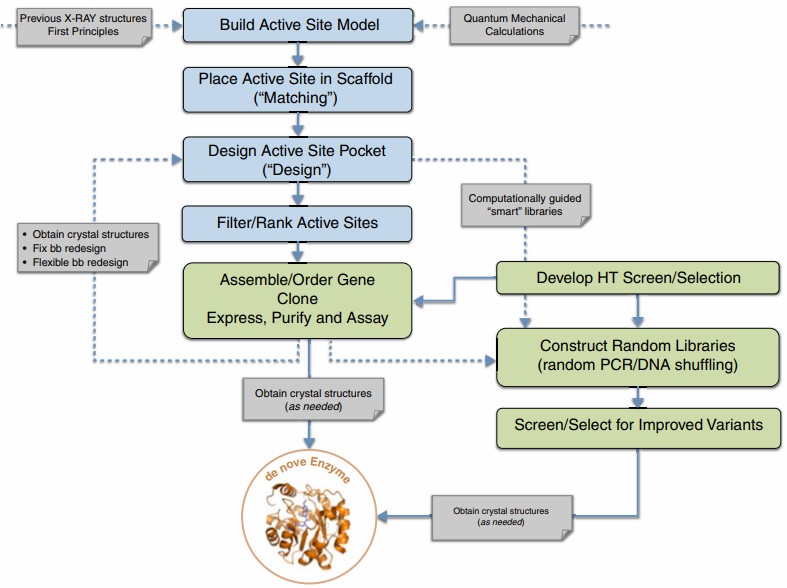01Overview
02Core Service Offerings
03Project Workflow
04Case Studies
05Application Areas
06Frequently Asked Questions (FAQs)
07Contact Us
Overview
CD Biosynsis aims to deliver timely and precise computational enzyme design services to its customers. A computational enzyme model is a powerful protein engineering tool. By computer simulation and algorithm-optimisation, enzymes are developed with a certain catalytic activity, stability and selectivity. With the combination of computational chemistry and bioinformatics, this technology can now be used to make enzymes design less a trial-and-error exercise, and more predictive and optimisation computationally.
Our computational enzyme design approach begins with enzyme structure modelling, starting with high-quality enzyme structure data, computationally modelling several possible enzyme variants, and evaluating the catalytic effectiveness and stability of these variants. And we also apply machine learning and deep learning methods to further improve the enzyme design and their activity. These technologies not only help to increase the productivity of enzyme design, but also save time and money in the experimental setting.
 Computational design of a novel enzymatic activity (Alexandre Z, et al., 2014)
Computational design of a novel enzymatic activity (Alexandre Z, et al., 2014)
In the real world, our computational enzyme design technology has found widespread applications in biotechnological areas ranging from drug discovery and industrial catalysis to environmental regulation. In close partnership with customers, we're still developing innovative enzyme design approaches for different industries.
We anticipate that computational enzyme design will become more important in the development of biotechnology going forward, as computational biology and artificial intelligence technology continue to evolve.
Core Service Offerings
The Computational Enzyme Design, offered by our company, consists primarily of the following:
Finding and screening enzymes: Using computer programs and databases, identify and screen enzymes to identify enzyme candidates with known functions.
Enzyme discovery and screening
Combining an energy function and a deterministic sequence optimization algorithm to design enzyme-ligand interaction.
Optimization of enzyme activity and specificity
Enhance enzyme activity and selectivity computationally, for example, through machine learning algorithms to determine the main sites that influence enzyme function, and design and adapt them.
Protein stability and kinetics studies
Explore the stability of enzymes in various environments and their catalytic reactions kinetics. For example, using molecular dynamics calculations and quantum mechanical calculations to grasp the structure-function relationship of enzymes.
Experimental verification and high-throughput screening
Coupled with the computation design results for experimental verification, high-throughput screening technology to quickly evaluate performance of several enzyme variants to determine the best enzyme candidate.
Customized technical services
Customized enzyme design services as per customer requirement such as enzyme tuning for specific reaction conditions, enzyme expression and purification, etc.
These services do not only include enzyme discovery, but also the integration of the most recent computing platforms and experimental techniques in order to perform the enzyme design tasks accurately and quickly.
Project Workflow
The process for Computational Enzyme Design provided by our company is the following:
Needs analysis and project start-up
Computational model construction
Enzyme design and optimization
Experimental verification
Data analysis and feedback:
Result delivery and subsequent support
- Needs analysis and project start-up: First, listen carefully to customers and find out their specific requirements such as enzyme-catalyzed reaction types, target products, reaction conditions etc. This step can require customers to provide chemical reaction data or biocatalysis background information.
- Computational model construction: The computational chemistry software is deployed to create a model of the enzyme on client demand. These include 3D model of the enzyme structure, active site analysis, and modeling of potential catalytic processes.
- Enzyme design and optimization: Enzymes are computationally optimized for greater catalytic efficiencies and selectivity. This step can involve any number of algorithms and simulations — molecular dynamics simulations, free energy computations, etc.
- Experimental verification: Enzymes are designed and produced, and tested experimentally in the laboratory for catalytic and selective activity. This step is one of the most important ones in confirming the model of the calculation.
- Data analysis and feedback: Collect experimental data and contrast it to computer simulations to test how the designed enzyme works. The calculation model was adapted from the experimental data to optimize further the enzyme design.
- Result delivery and subsequent support: Provide customers with the final designed enzyme and associated information, such as the enzyme's sequence, structure and catalytic activity. Meanwhile, it offers necessary technical support and a follow-up so that customers can take advantage of these outcomes.
By doing all of this above, our Computational Enzyme Design service would enable customers to have effective and customized enzyme design services in order to achieve breakthroughs in the area of biocatalysis.
Case Studies
Calculation design of glyceraldehyde triphosphate isomerase activity
Research background: Glyceraldehyde triphosphate isomerase (TPI) is a fundamental enzyme that converts glyceraldehyde triphosphate into dihydroxyacetone phosphate during glycolysis. But TPI is not highly active in some animals, limiting its use in biosynthesis and metabolic engineering.
The solution: We used computational enzyme design technology to predict and introduce 18 to 22 mutations into ribose-binding proteins, which typically lack enzymatic activity. These designs were predicted by calculations and verified by experiments, and successfully increased the activity of TPI by 105 to 106 times, supporting the growth of Escherichia coli under genogenic conditions.
Results: The design not only improved the catalytic efficiency of the enzyme, but also verified its biological activity through experiments, proving the feasibility and effectiveness of the computational enzyme design method.
Application Areas
These are the main use and application domains of Computational Enzyme Design services:
Biotechnology applications
Enzymes are used in numerous biotechnical applications ranging from biofuel production, biopharmaceuticals, protection of environment, etc. Enzymes that are functional can be designed computationally to serve precise functional requirements in these domains.
Pharmaceutical research and development
Enzyme design and optimization in pharmaceutical manufacturing is crucial to drug design and rewiring metabolic pathways. Computer-based enzyme design can enable scientists to create more effective enzymes for drug manufacture or drug metabolism.
Food industry
Amylases, for instance, can convert starch, proteases, can soften meat, etc. Computational enzyme design could be applied to the food industry in order to create more efficient and safer enzyme preparations.

Chemical industry
Enzymes can be used in chemical reactions such as esterification reactions, oxidation reactions, etc. It is possible to design enzyme catalysts that work better, which can be computationally designed to optimise chemical production while also being more sustainable.
Environmental governance
here are also significant applications of enzymes for environmental governance (degradation of plastics, and wastewater treatment of pollutants). This computational enzyme design can lead to improved enzymes for environmental governance and pollution control.
Agriculture
Enzymes can be applied in the agriculture to ensure growth of the crops, and eliminate diseases and pests. In computer enzyme design we can create more productive enzyme preparations for crop yield and quality.
The Computational Enzyme Design services offer broad market potential for applications in fields such as biotechnology, pharma development and research, food, chemical industry, environmental management, and agriculture. Providing effective and custom enzyme design services can help customers to resolve certain technical challenges and increase productivity and product quality.
Frequently Asked Questions (FAQs)
These are the common question and answers related to Computational Enzyme Design Services. With these FAQs, customers will be able to get an idea about your company's Computational Enzyme Design services:
Q: What is Computational Enzyme Design?
A: Computational Enzyme Design is a technique that takes advantage of advances in computational chemistry and biology to engineer proteins that enable natural, slow-motion reactions. The approach combines high-performance computing, quantum theory and molecular dynamics theory and practice to take enzyme engineering to a whole new dimension.
Q: What are the advantages of this design method?
A: The advantage of this method is that it can efficiently navigate large sequence spaces, greatly reducing experimental burden, while providing enzymes with specific catalytic activities, stability and selectivity. In addition, computational methods can create completely new enzymes that can catalyze a variety of bond cleavage and bond formation reactions.
Q: How does our company design and transform enzymes?
A: Our company adopts a "bottom-up" approach, starting with the generation of relevant theoretical enzymes, then establishing a transition-state model of the enzyme, and optimizing its catalytic efficiency and stability through calculations. In addition, we also used dynamic set assessment and mutation effects to further improve enzyme performance.
Q: Does our service cover all enzymes?
A: Our products are applicable for all enzymes and enzymes that need a better catalytic efficiency and stability. But some applications might require custom solutions.
A: Our service fees vary based on the level of the project and the design accuracy required. We will give customers specific quotes according to their requirements and approve them before the final agreement.
Q: How to measure the effectiveness of Computational Enzyme Design?
A: Determining the success rate of Computational Enzyme Design typically involves experimental confirmation that the designed enzyme is catalytically effective. Success rate is determined experimentally by measuring the activity, specificity and stability of the designed enzyme.
Our team uses the latest computational methods, such as molecular dynamics simulations, to improve enzyme activity and selectivity. We are committed to exploring complex protein-adaptive landscapes through data-driven methods to achieve big leaps in function. If you are interested in our services, please feel free to contact us.

































 Computational design of a novel enzymatic activity (Alexandre Z, et al., 2014)
Computational design of a novel enzymatic activity (Alexandre Z, et al., 2014)